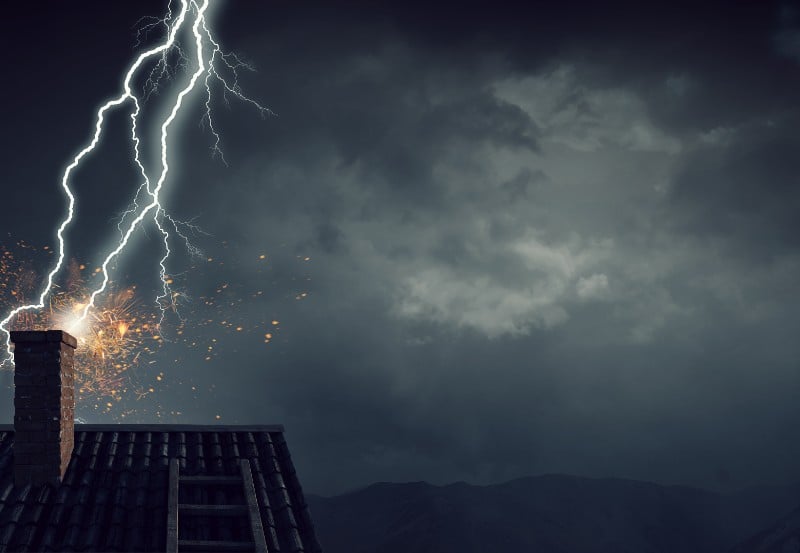A UK winter (and often summer) wouldn't be complete without a couple of storms.
Bad weather and storm damage can leave chaos and destruction behind, especially towards peoples' homes.
But does your home insurance cover storm damage? And what's the true definition of a storm? Here we take a look.

What is storm and weather damage?
Storm and weather damage refers to damage from events like strong winds, heavy rain, hail, snow, and ice.
This can include roof damage from high winds, flooding from heavy rain, and damage from fallen trees or power lines. Home insurance policies often cover various types of storm damage, such as wind, hail, water, and frozen pipes.
Does home insurance cover storm damage?
Yes. The good news is that home insurance typically covers against sudden, unforeseen events like storms and bad weather. And if your home is left uninhabitable, your insurer should pay for alternative accommodation until repairs have been made.
Home insurance typically covers storm damage to the structure of your house through your buildings insurance, and to your belongings through contents insurance.
Many insurers exclude outbuildings like fences, garden sheds, gates, and hedges, unless you have specific cover for them.
Home insurance can cover damages such as:
Roof damage
This might be tiles blown off the roof, or damage from a fallen tree due to strong winds.
If your roof has blown off from storm damage, home emergency cover helps to make quick repairs to keep your house dry.
It's worth noting that home insurance won't cover general wear and tear. Or damages caused by poor maintenance, so make sure you stay on top of any repairs. Our home maintenance checklist can help remind you what needs looking at throughout the year.
Lightning damage
Yes, your buildings insurance policy should cover lightning damage to the structure of your home.
Most home insurers should cover for damages due to natural disasters that are out of our control, like lightning. These are sometimes called 'Acts of God'.
A separate 'Act of God' insurance policy doesn't exist, but if you read your policy you should find a list of natural disaster risks that they cover for.
Flood damage and resulting leaks
Water damage from excessive rainfall or melting snow is often included.
Contents insurance usually covers storm damage to your personal belongings and household goods. But it's always worth checking the details of your individual policy. You might want to consider getting accidental damage cover too. You can get this as part of your contents insurance, buildings insurance or both.
What’s usually excluded from storm damage cover?
Wear and tear
Damage that results from the natural aging of your property isn't covered.
Poor maintenance
Most insurance policies say you must properly maintain your property. Insurers can refuse storm damage claims because of poor maintenance.
Let's say you make a claim for storm damage because your roof tiles have blown off. If the insurer inspects the roof and it turns out that the roof tiles were already damaged, they can refuse the claim.
Or, say you claim for water damage to your house after a storm. If the insurer discovers that the gutters aren't clear, they could refuse the claim.
DIY accidents
Damage that occurs from things such as cutting down a tree yourself won't be covered.
Fences
Fences aren't normally covered for storm damage under standard home insurance policies. But it's worth checking your specific policy to be sure.
What counts as a storm?
The definition of a storm according to The Financial Ombudsman is:
"[Something that] generally involves violent winds, usually accompanied by rain, hail or snow".
Some insurers, but not all, define storms in more detail on their policy documents.
These definitions usually have a specific wind speed. The Met Office uses the Beaufort Scale which has a scale of 0 to 12 to describe wind speed:
| Beaufort wind scale | Description | Wind speed (mph) |
|---|---|---|
|
0
|
Calm
|
<1
|
|
1
|
Light air
|
1-3
|
|
2
|
Light breeze
|
4-7
|
|
3
|
Gentle breeze
|
8-12
|
|
4
|
Moderate breeze
|
13-18
|
|
5
|
Fresh breeze
|
19-24
|
|
6
|
Strong breeze
|
25-31
|
|
7
|
Near gale
|
32-38
|
|
8
|
Gale
|
39-46
|
|
9
|
Strong gale
|
47-54
|
|
10
|
Storm
|
55-63
|
|
11
|
Violent storm
|
64-72
|
|
12
|
Hurricane
|
73+
|
There are typically a lot of complaints because insurers dispute whether there was a 'storm' to begin with.
The Financial Ombudsman says they use The Met Office as an indication to find out:
- If there was a storm
- How intense the storm was
- How close the storm was to the insured property
Each insurer's definition of a storm is different, so it's worth looking at the specific wording of your home insurance policy. If it's not in your policy, you can ask and make note of the conversation in case you need it for future use.
"Having home insurance in place helps protect your building and contents from potential storm damage, particularly if you live in an area at high risk of flooding.
"It's also important to buy home insurance if your home has features like a thatched roof, timber frames or is made of wattle and daub. These kinds of homes are typically made from old-fashioned construction methods, which makes them more likely to suffer storm damage.
"It's also worth checking how much home insurance cover you need to avoid missing key features that help cover your home from storm damage."
What our home & lifestyle insurance expert says

Is storm damage insurance worth it?
Yes, storm damage insurance is often worth it. Especially if you live in an area with a high risk of severe weather. Most home insurance policies, whether that's buildings, contents, or a combined policy will include storm damage. But the specifics vary by provider, so always check your policy carefully.
Having storm damage cover is usually worth it if:
- You live in a high-risk area for storms or flooding.
- You have a home with construction methods more susceptible to storm damage. This might include gable roofs or weak connections between the roof, walls, and foundation. Buildings constructed with stone and brick with mud mortar are also more prone to storm damage.
- The potential cost to repair damages would be financially devastating to you.
- A claim is necessary to cover more than your excess. And you are prepared for a potential increase in your renewal premium.
It's easy to underestimate how much structural damage storms can do. In 2024 for example, storm Darragh resulted in a major incident due to fallen trees. Widespread structural damage was reported, including a unit torn from Llandudno Pier and a chapel roof ripped off in Powys. A large payout for weather-related damage was recorded in 2024, highlighting the benefits of getting insurance.
With storms causing huge disruption across areas of the country, it's important to consider the benefits of storm damage cover.
How do I make a claim for weather damage to my home?
Here are the 5 steps you'll need to take when making a home insurance claim:
- Check your buildings and contents policy to see what cover you have.
- Carefully check what damage has been done to your home. Don't try to carry out any repairs yourself unless absolutely necessary. If the damage is severe, you may need to find alternative accommodation until your home is in safe condition again. Your insurer may be able to reimburse the cost of emergency accommodation.
- Take photos or videos of any damage caused, as this can be used as evidence. Don't throw anything away until the claim is settled.
- Contact your insurer with the details, being as thorough as possible.
- If you need emergency repairs after a storm, keep all receipts for any work done so you can claim the cost back.
Tips for protecting your home against storm and weather damage
We can't always prevent disaster, but there are ways to reduce the risk of major damages:
Ongoing maintenance
Keeping your home in tip-top shape is a great way to reduce the risk of potential damage. Here's a few things to keep on top of throughout the year:
- Roof and chimney: Inspect for damage annually. Check for loose, cracked, or missing tiles, and crumbling mortar around the chimney and flashing.
- Gutters and drainage: Clear all gutters and downpipes of leaves, moss, and debris, especially before winter.
- Trees: Trim any overhanging branches close to your house, garage, or power lines.
- Water pipes: Insulate exterior pipes, keep heating on low during cold weather.
Tips to prepare for a storm
Check the Met Office weather warnings to get the best, most up to date information about incoming storms. Here are a few things to do once you know a storm is coming:
- Secure furniture: Secure or put any outdoor furniture away. This might include trampolines, toys, and anything that can be moved by strong winds. If you keep valuable items outside, you can also get garden cover as a policy extra.
- Lock windows and doors: Keep windows and doors locked to reduce the risk of winds blowing them open and smashing glass.
- Check for any loose fence panels: Limit potential damage by making sure no fence panels are loose.
- Check your loft: Look out for any damage or gaps that could get worse in a storm, or allow leaks.
Storm and weather damage insurance should come as part of your home insurance policy, but levels of cover vary between providers.
If you think your home is at risk of storm damage it’s important to check the terms and conditions on your policy.








